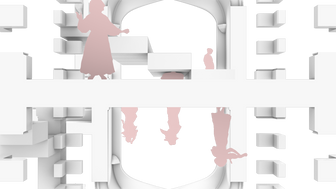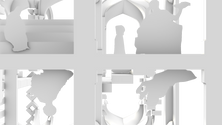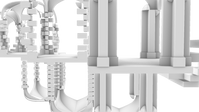
“The dead make innovations in their city”
“The living to keep up with them, also want to do everything …… about the novelties of the dead”
“The job of accompanying the dead down below and arranging them in the desired place is assigned to a confraternity of hooded brothers. No one else has access to the Eusapia of the dead and everything known about it has been learned from them.”

Eusapia
In the carefree city of Eusapia, in order to make the transition from life to death less abrupt, the ‘Eusapians’ created an identical city underneath. In the underground city, the dead carried on living in the same manner as in actual life, albeit in a more contented manner. However there were some who aspired for more in life, and these people could realize their unfulfilled aspirations only after death. The ‘dead’ enjoyed a more fulfilled and contented existence, and in times of quiet contemplation, innovated their city and made it better. The living eventually decides to copy the dead and improve their own existence. The cities thus become very similar to one another, until it becomes difficult to distinguish which is living, and which dead. A true state of immortality is achieved therein. The notations show the direction of time when innovations in the upper and lower city are carried out from right to left. The heaviness of the atmosphere is deepest at the central part of the story where the living desire a better existence after death and then start to innovate in order to copy the dead which is denoted by a greater number of concentric circles. Glance and gaze show the direction toward where the figures in the story look towards as they interact with each other and contemplate changes into the future.
Perspective 1
Perspective 2

In the first perspective, I have tried to depict that the living wished a better existence after death. The upper city architecture is symbolically askew, careless, and lacking in order. The dead beneath have created structures that are more methodical and organized in orientation. The atmosphere in the city above is dissatisfied, looking for a better chance in the afterlife, whereas the scene below is excited and happy and, mystical and enduring. The green excitement wash is chosen as the dead are excited and the living yearns for the same state of being.
In the second perspective, the frame moves to the next aspect of the story, where the living decide to copy the dead, and better their state of living. The hooded brother is the link between the two worlds, who relates aspects of the life after death to the living. The change is reflected in the identicality of the architecture in the last frame towards the right and pictorially also, where the upper and lower scene reach a state of tranquility with the sweet strains of the violin encompassing both the worlds. A yellow tranquility wash is chosen as it represents calm effort and achievement of tranquillity.

Experimenting with different iterations of composition and camera angles
Take away...
This module involved an amalgamation of all the skills we developed over the course of this semester. We explored the relationship between field and frame in order to represent our interpretation of the city assigned to us, using the Old Quad model as the foundation. The text represented a complex abstract concept that formed the basis for the form of the city as a whole.
Interpreting the city accurately as well as realizing what to depict was an iterative exploratory process that involved reading the text multiple times, moving back and forth between various components, trying many different designs making sure that everything links to each other. We learned, through trial and error, how to represent the intangible changing city by curating a narrative and indicating it through the notations on the isometric field. We also experimented with various camera angles inset within the field with the limitation of them being perpendicular to each other, in order to get the two best perspectival frames of our field to depict the highlights of our narrative. Finding the correct angles for perspectives was a highly investigative process that involved moving back and forth between the two views, as well as the isometric field. With my story particularly, I wanted to depict two layers, one above [living] and one below [dead] where I struggled with various iterations before coming to the final one with a balanced out readability. The innovations in my city were subtle and although this was intentional, it might not come out as clearly to the viewer without proper indication. Therefore, in retrospect, I think I should have made them much more apparent to make it coherent to the viewer at first sight. Overall, I was fairly satisfied with my outcome as it depicted the concept I extracted from my story accurately.

























